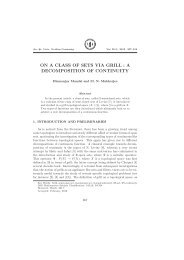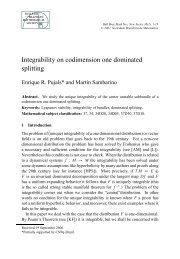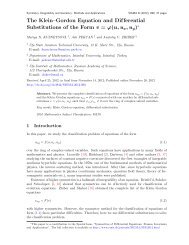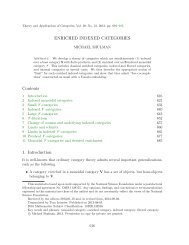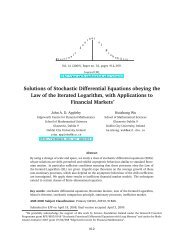Bounded Oscillation Of Higher Order Neutral Differential Equations ...
Bounded Oscillation Of Higher Order Neutral Differential Equations ...
Bounded Oscillation Of Higher Order Neutral Differential Equations ...
You also want an ePaper? Increase the reach of your titles
YUMPU automatically turns print PDFs into web optimized ePapers that Google loves.
A. Zein and T. Abu-Kaff 129Setting u (t) =λcz (n−1) (t),and integrating (14) divided by w (u (t)) from t 7 to t, weobtain t u(t7 )dsλc φ (v) dv ≤t 7 u(t) w (s) . (15)Since u (t) < 0, u (t) is decreasing. And since u (t) > 0, it follows that lim t→∞ u (t) =L ≥ 0. If L = 0, then by (15) we must have ∞φ (t) dt < ∞, (16)t 7which is contrary to (8). In the case when L = 0, letting t →∞in (15) and using (7),we again obtain (16). The proof is complete.In the next theorem besides conditions (H1)-(H4) we further assume that:(H5) 0 0fort>0 is continuous and nondecreasing on R + with:|y||f (t, x, y)| ≥ φ(t)w[t − σ (t)] n−1 (17)andIf n is odd and ±α0dx< ∞ for every α > 0. (18)w (x) ∞φ(t)dt = ∞, (19)then every bounded solution x(t) of equation (1) is oscillatory.PROOF. Assume that equation (1) has a bounded non-oscillatory solution x(t).Without loss of generality, we may assume that x(t) is eventually positive (the proofis similar when x(t) is eventually negative). That is, let x(t) > 0, x(τ(t)) > 0andx(σ(t)) > 0fort ≥ t 0 ≥ 0. Set z (t) as in (9). Then from (1) and (9) we have (10). From(10) z (n) (t) < 0. It follows that z (i) (t) (i =0, 1, ..., n − 1) is strictly monotonic and ofconstant sign eventually. Since p (t) andr (t) are oscillating functions, lim t→∞ p (t) =lim t→∞ r (t) =0, and x(t) is bounded, there exists a t 1 ≥ t 0 such that z(t) > 0fort ≥ t 1 . Since x (t) is bounded, and by using lim t→∞ p (t) = lim t→∞ r (t) =0,thenitfollows from (9) that there is a t 2 ≥ t 1 ,suchthatz (t) is also bounded for t ≥ t 2 .Now, by applying Lemma 1, there exist a t 3 ≥ t 2 and an integer l with n − l oddsuch that (2), and (3) are satisfied by z (t) fort ≥ t 3 . Since n is odd and z (t) isboundedthen l =0(otherwisez (t) is not bounded). Hence from relations (2), and (3) we have(−1) k z (k) (t) > 0, k =0, 1, ..., n − 1. (20)
130 <strong>Oscillation</strong> of <strong>Neutral</strong> <strong>Differential</strong> <strong>Equations</strong>Since n is odd, from (H5) and (20) follows that we can apply Lemma 2. Using Lemma2, we haveHence,z (σ (t)) = z (t − (t − σ (t))) ≥[t − σ (t)]n−1z (n−1) (t) , t ≥ t 3 + σ 0 .(n − 1)![t − σ (t)]n−1z (σ (t)) ≥ z (n−1) (t) , t ≥ t 3 + σ 0 . (21)(n − 1)!Since x(t) isbounded,by(H1)itfollowsthatlim t→∞ p (t) x(τ(t)) = 0 . Then usingthis fact with lim t→∞ r (t) = 0, and by (9) there exists a t 4 ≥ t 3 such thatx (t) ≥ λz (t) , t ≥ t 4, (22)where λ is some number in (0, 1).Let t 5 ≥ max{t 4 ,t 3 + σ 0 } be such that σ (t) ≥ t 5 for all t ≥ t 5 . From (21), and (22)we havex (σ (t))[t − σ (t)] n−1 ≥ λz(n−1) (t),(n − 1)!t ≥ t 5 . (23)Using (17), and (23), then it follows from (10) that z (n) (t)+φ (t) w λcz (n−1) (t) ≤ 0, (24)where c = 1omit it.(n−1)!. The remainder of the proof is similar to that of Theorem 1 and we4 ExamplesWe consider two examples.EXAMPLE 1. Consider the equationx(t)+4e − t+π2 sin t t − π2 x + e t−π62 4+2e −56 t cos 2 3 t x 1 3 t − π 2= −4e − t 16 cos 3 t.By setting w(x) =x 1 3 , φ(t) = t − π 132e t−π6 4+2e −56 t cos 2 3 t ,wecanseethatallconditions of Theorem 1 are satisfied. Thus every bounded solution of the aboveequation is oscillatory. In fact, x(t) =e −t sin t is such a solution.EXAMPLE 2. Consider the equationx(t)+4e − t+π2 sin t t − π2 x 2= −4e − t 6 sin13 t − 2e −t cos t. + e t−2π64 − 2e −56 t sin 2 3 tx 1 3 (t − π)



